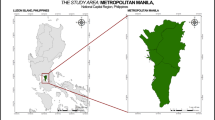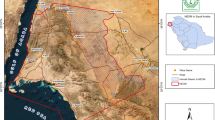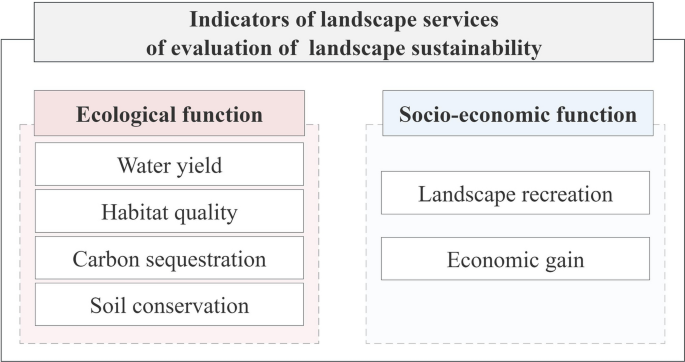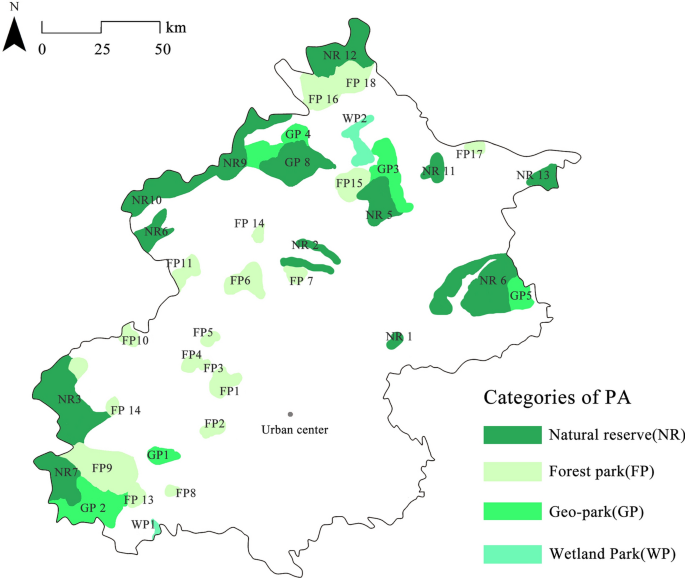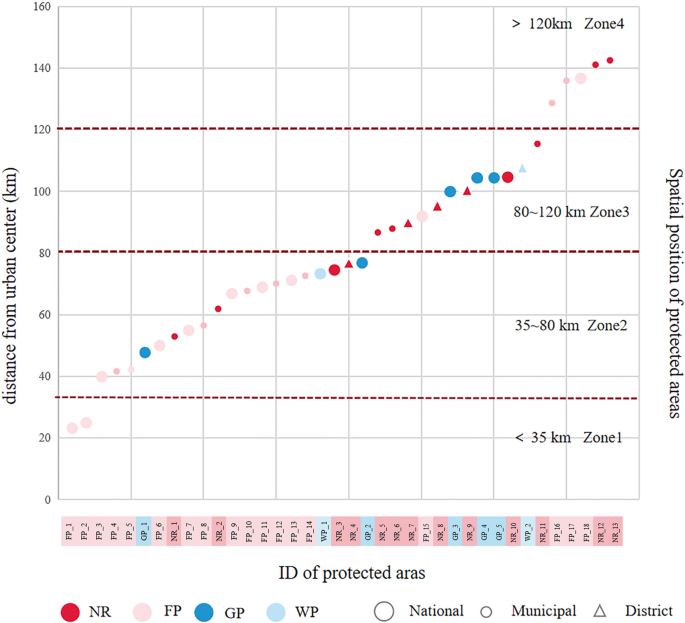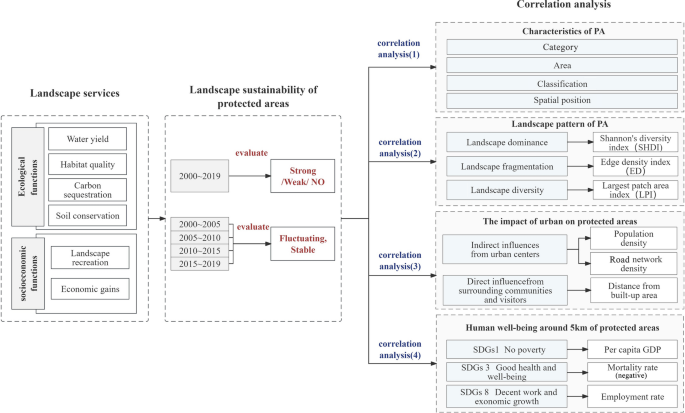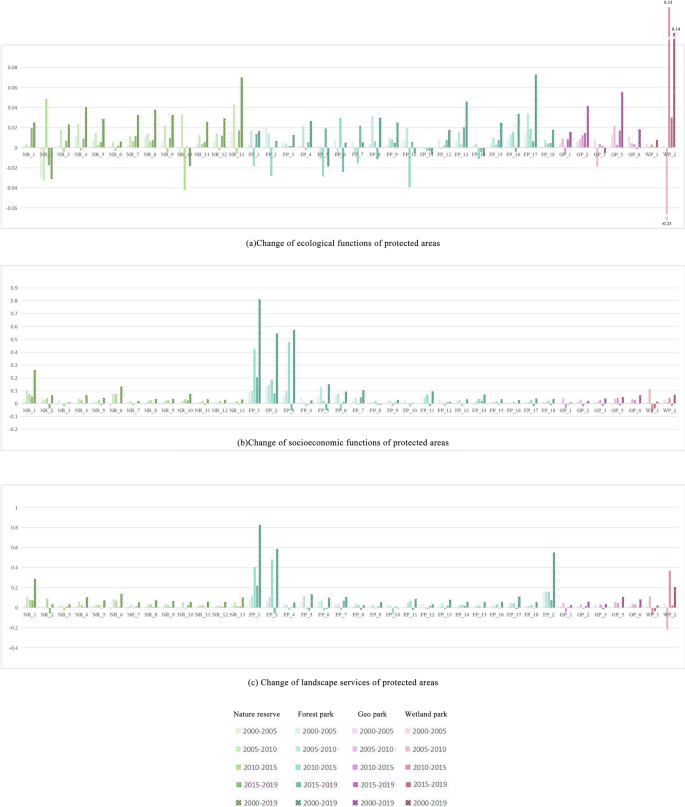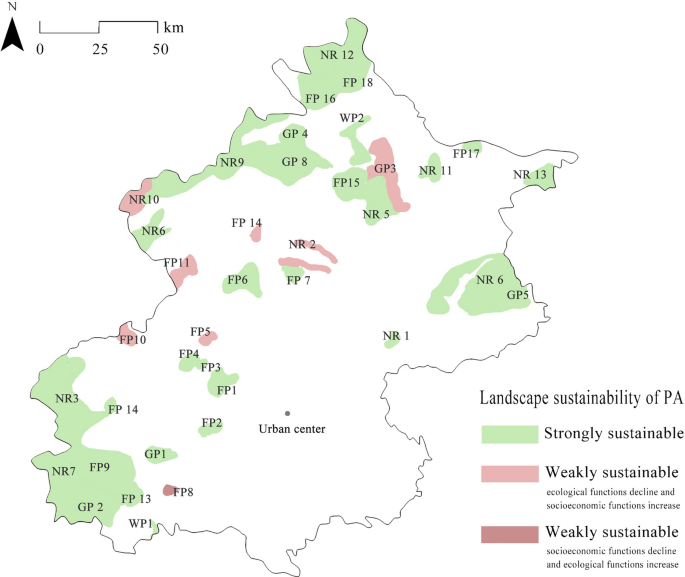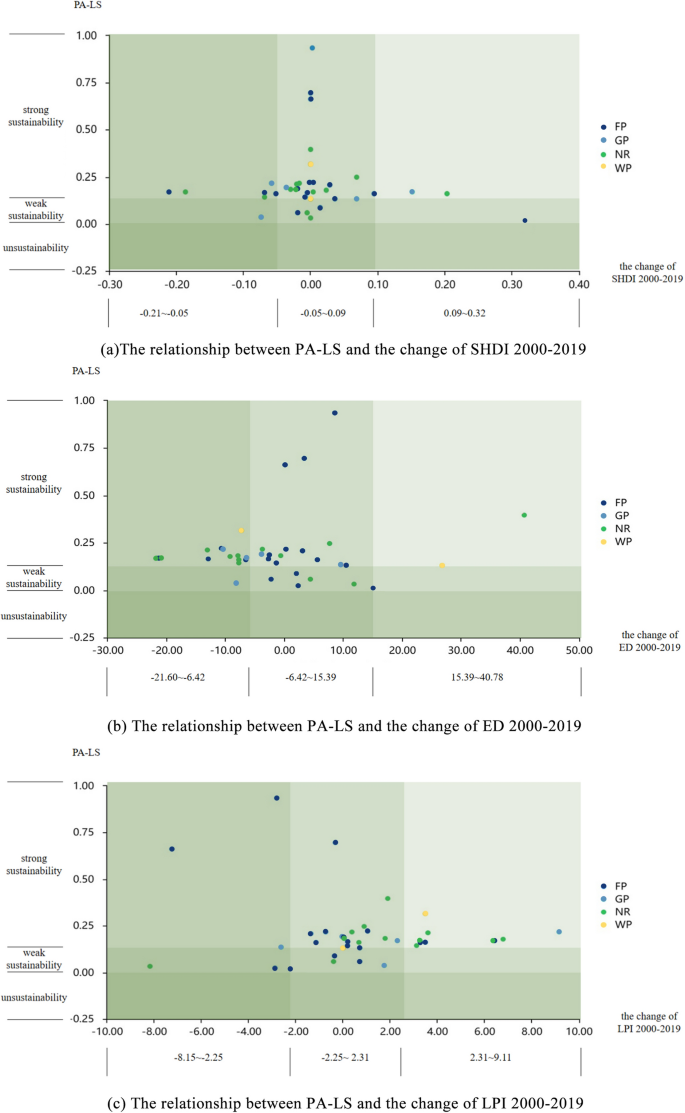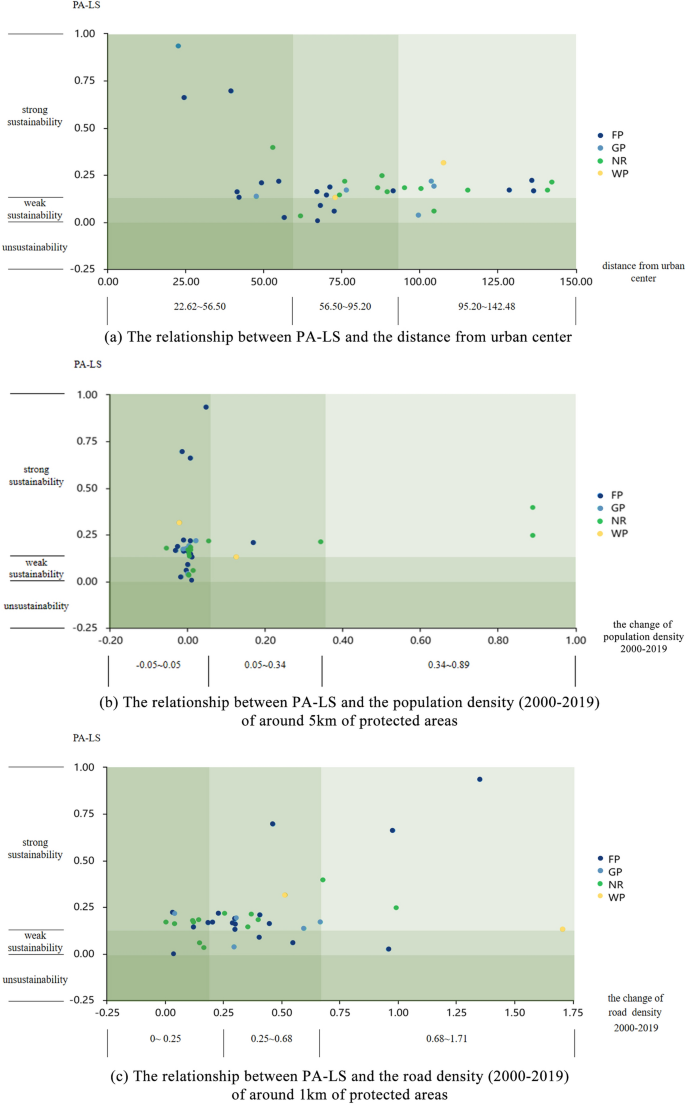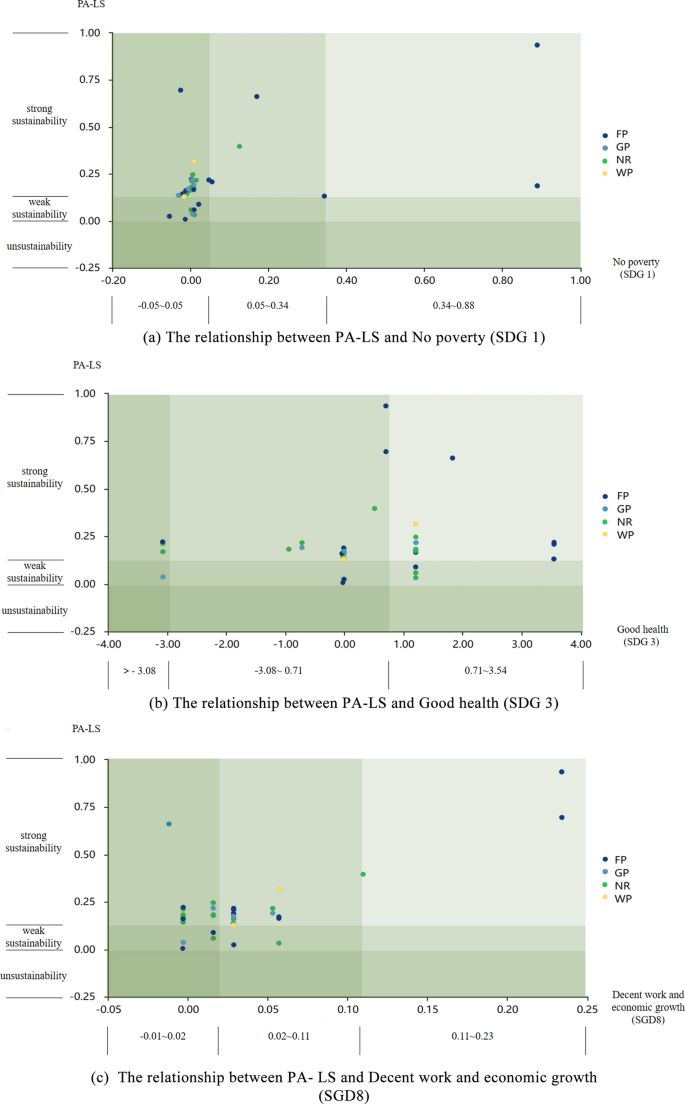Abstract
Context
Protected areas (PAs) serve as robust safeguards for the ecological safety of urban areas, and positively affect their socioeconomic development. However, limited research that integrates both ecological and socioeconomic aspects to evaluate the role of PAs.
Objectives
In this study, we aimed to establish an evaluation framework for PAs that applies the concept of landscape sustainability and integrates ecological and socioeconomic functions to enhance understanding of the role of PAs. Additionally, we aimed to develop analytical framework for identifying the correlation elements of landscape sustainability of protected areas (PA-LS) and improving the understanding of the mechanisms underlying PAs.
Methods
This study focused on 38 PAs in Beijing, China. We established the PA-LS evaluation framework to evaluate the role of PAs by analyzing changes in their overall landscape services from 2000 to 2019, and in ecological and socioeconomic functions. Subsequently, an analytical framework was established to identify the correlation factors of PA-LS, focusing on four aspects: the fundamental characteristics of PAs, landscape patterns of PAs, impact of urban areas on PAs, and human well-being within a 5 km buffer of PAs.
Results
The landscape sustainability evaluation of Beijings’ PAs revealed that 30 PAs (78.95% of the total) were strongly sustainable, eight (21.05%) were weakly sustainable, and none unsustainable. The results revealed that there was a positive correlation between several factors and PA-LS, including the density of the road network within a 1 km buffer of the PAs and the economic income and employment rate within a 5 km buffer of the PAs. Conversely, there was a negative correlation between one factor and PA-LS, its the distance between PAs and the urban center. Other factors, such as the category, area, classification of PAs, SHDI (ecological land), ED, LPI (forest) of PAs, and population density and residents’ health within a 5 km buffer of the PAs, were unrelated to PA-LS.
Conclusions
This study established a PA-LS evaluation framework and its correlation factor analytical framework, which significantly contributes to enhancing the value cognition of PAs and enriching landscape-sustainability evaluation methods. Furthermore, the study provides valuable support and serves as a reference for the conservation and management of PAs in Beijing and similar metropolitan cities.
Similar content being viewed by others
Avoid common mistakes on your manuscript.
Introduction
Protected areas (PAs) serve as robust safeguards for the ecological safety of cities and positively affect socioeconomic development in urban areas (Fu 2018; McNeely 2020). An evaluation framework that integrates ecological and socioeconomic aspects should be established to comprehensively reveal the role of PAs in cities.The previous studies on the evaluation of the role of PAs have primarily focused on their effectiveness in protection and management (Elleason 2021; Gonçalves-Souza 2021; Jin 2021; Zhao 2023), and ecological functions, while insufficiently on social functions.
Some evidences have demonstrated that PAs can reduce poverty and enhance the effectiveness of conservation (Walker 2009; Andam et al. 2010; Peng et al. 2020), but research combining ecological and socioeconomic aspects to evaluate the role of PAs is limited (McKinnon 2015). The proper evaluation of PAs was hindered this limitation.
As a comprehensive concept, sustainability reflects change in ecological and socioeconomic functions, and represents their balance and interaction (WCED 1987; Kates et al. 2001; Wu 2006). Numerous academic fields have acknowledged the notion of sustainability and developed discipline-specific concepts accordingly (Thayer 1989; Bettencourt and Kaur 2011; Wu 2014). Landscape sustainability emphasizes the long-term and stable provision of specific ecosystem services by a particular landscape (Wu 2013; Opdam et al. 2018; Zhou et al. 2019).
It identifying functions from a landscape perspective, rather than focusing solely on ecological elements (Termorshuizen and Opdam 2009). Therefore, the concept of landscape sustainability can take into account the ecological, social, and economic functions (Wu 2012) and is suitable for the evaluation framework combining ecological and socioeconomic benefits. Recently, landscape sustainability has been used to evaluate the functionality of farmland fields (Fu et al. 2006; Eichler et al. 2018), urban areas (Wu 2008; Huang et al. 2015; Yoffe et al. 2022), and ecological zones (Termorshuizen and Opdam 2009; Xu et al. 2020). However, this method has not been employed in the evaluation of PAs.
This study provides a comprehensive review of landscape sustainability evaluations, encompassing evaluation methodologies, evaluation indicators, and correlation analyses based on the results.
Two distinct aspects are incorporated into the evaluation of landscape sustainability. One aspect is centered on the temporal evolution of single or multiple essential landscape services. Fan et al. (2021) quantified the ecological evolution of the Qinghai–Tibet Plateau to determine the extent of its sustainability. The other aspect encompasses the correlation between the supply and demand of landscape services, enabling the evaluation of landscape sustainability at the city and county levels (Jia et al. 2018; Yao 2021). Some urban area sustainability studies (Tanguay 2010; Wang 2018) and land-use sustainability studies (Liu 2013; Zhu 2021) have categorized these concepts into distinct levels; strong sustainability, weak sustainability, and unsustainability (Solow 1974; Daly 1997; Wu 2014). By evaluating the progression of ecological and socioeconomic indicators, the comprehensive functionality of research object’s sustainability can be ascertained (Huang 2018; Wu 2019). This evaluation method is yet to be explored in the practice of landscape sustainability evaluation.
This study examined the ecological, and socioeconomic indicators employed in existing landscape sustainability researches, to guide the development of a comprehensive evaluation framework for PAs. The four leading ecological indicators are water conservation, soil and water conservation, carbon sequestration, and habitat quality (Fan et al. 2021; Gong and Liu 2021).
Regarding social and economic indicators, those selected in existing landscape sustainability studies were closely aligned with the characteristics of the evaluation objects. For instance, Jia et al. (2018) evaluated Mizhi County’s economic function using indicators such as grain production per unit area, per capita net income, livestock count, and social function using indicators such as education level, road network density, and the number of reservoirs constructed. Studies on the benefit evaluation of PAs provide valuable references for selecting socioeconomic indicators For example, tourist volume and economic gains can comprehensively reflect the social and economic benefits (Eagles 2002). Indicators of landscape services of evaluation of landscape sustainability as shown as Fig. 1.
Concerning correlation analysis, some studies have conducted correlation analyses after evaluating landscape sustainability to gain a deeper understanding of the correlation factors of and provide targeted optimization suggestions. Gong and Liu (2021) examined the impacts of land-use policies on landscape sustainability and proposed recommendations for formulating effective land-use policies. Since correlation studies on landscape sustainability evaluation are relatively few, this study also examined the correlation analysis in the research of ecosystem service evaluation and PAs benefit evaluation.
Fundamental characteristics of the research object, landscape patterns (Gilman and Wu 2023), human well-being, and urban impact are commonly utilized factors in correlation analyses of ecosystem services evaluation. The indicators of these factors as follows: the commonly indicators of fundamental characteristics are the classification, type, and area of PAs (Zhao et al. 2023), the commonly indicators of landscape patterns shannon diversity index (SHDI), edge density (ED), and largest patch index (LPI), the commonly indicators of human well-being such as GDP, mortality rate (negative value), employment rate (Tao and Wu 2019; Ghoddousi et al. 2022; Xu et al. 2022; Schulze et al. 2022). The “distance from the urban center” is utilized to evaluated the urban influence, encompassing a comprehensive quantification of all indirect impacts exerted by cities on PAs.
Direct impact from urban is a common factor for correlation analysis when evaluating PAs (Edmiston et al. 2014), one commonly used indicator is the population density surrounding PAs, as highlighted by Yang and Tang (2022). In addition, it is necessary to consider the road network density around PAs as an indicator of direct urban impact. This indicator is reference from Sahitya (2020)’s research findings, which emphasize the relationship between road network density and accessibility.
There are two levels of questions in this study:
At the methodological level, the research questions are as follows: How can we develop a landscape-sustainability evaluation framework for PAs that accurately captures their unique characteristics while encompassing ecological and socioeconomic functions? How can we establish a framework for identifying the correlation factors of landscape sustainability of protected areas (PA-LS)?
At the case-study level, the research questions were as follows: What is the current state of landscape sustainability of Beijing’s PAs? Which elements are pertinent to the PA-LS?
This study has two research objects. The first research object was to establish an evaluation framework for the PA-LS. This study divided landscape services into ecological functions, and socioeconomic functions. The PA-LS was evaluated by analyzing the changes in ecological functions, and socioeconomic functions on the temporal evolution, as well as the changes of total landscape services. The second research object was to establish an analytical framework to identify the correlation factors of PA-LS. The study has chosen four categories for correlation analysis with PA-LS: fundamental characteristics of PAs; the landscape patterns of PAs; the urban impact on PAs; and human well-being in the areas surrounding PAs.
This study applied these two frameworks in Beijing, examined the changes in the landscape services of 38 PAs from 2000 to 2019, evaluated PA-LS, and identified the correlation factors that affect PA-LS.
This study highlighted two cognitive gaps. Firstly, a lack of an integrated framework applies ecological and socioeconomic functions to evaluate PAs. Secondly, landscape sustainability evaluation has yet to be applied to PAs. Therefore, this study aimed to fill these two gaps by exploring the application of the landscape sustainability concept in PAs and establishing an evaluation framework that integrates ecological and socioeconomic functions. Moreover, it establishes an analysis framework to identify the correlation factors, and deepen the comprehension of the operational mechanisms underlying PAs.
Additionally, at the application level, this study applied the concepts of strong and weak sustainability to evaluate PAs. This study categorized landscape services into ecological and socioeconomic domains, evaluated the PA-LS. By comparing the temporal changes in total landscape services, ecological functions, and socioeconomic functions, the evaluation is conducted to determine whether PAs exhibit a state of strongly sustainable, weakly sustainable, or unsustainable. These results provide a more intuitive evaluation approach and enriched the existing methods for evaluating landscape sustainability.
Finally, using Beijing as an case, this study evaluated the PA-LS in Beijing. This study identified the correlation factors, provided empirical support for protection, and management of PAs in Beijing, and provided a reference for PAs in similar large cities.
Methodology
Study area
Beijing, located on the North China Plain, is surrounded by mountains to the west, north, and northeast, and open plains to the southeast. Covering a total area of 16,410 km2, Beijing serves as China’s political and cultural center and is one of China’s ten mega-cities. Over the 20 years from 2000 and 2019, Beijing developed rapidly regarding both urbanization and the establishment of PAs. The urbanized area of Beijing expanded from 491 to 1469 km2, and the permanent population grew from 13.819 to 21.536 million. Simultaneously, the achievements of the PA system of Beijing have also been remarkable, with the proportion of protected area to the city area has increased from 10 to 22% (Beijing Municipal Forestry and Parks Bureau 2021). Throughout this changing process, the spatial dynamics and interactions between the urban areas and PAs underwent significant changes. Therefore, this study uses Beijing as a case study.
In 2019, The Guidance on the Establishment of the Protected Areas System with National Parks as the Main Body was issued by the General Office of the CPC Central Committee and the General Office of the State Council which specifies the classification of PAs. Beijing’s protected areas include nature reserves (NR), forest parks (FP), geo-parks (GP), and wetland parks (WP). Scenic and historic interest areas were excluded from this study because they overlapped with other PAs. This study takes 38 protected areas (including 13 nature reserves, 18 forest parks, 5 geo-parks, and 2 wetland parks) as research objects (Fig. 2).
In this study, the spatial position of PAs was classified into four types based on the distance from the urban center (Fig. 3): Zone1, within 35 km; Zone2, between 35 and 80 km; Zone3, between 80 and 120 km; and Zone 4, beyond 120 km.
Data sources
This study contains several datasets as depicted in Table 1.
Framework
We established a framework for the evaluation of PA-LS and identification of its correlation factors (Fig. 4).
The evaluation framework of PA-LS
Concerning the evaluation method of PA-LS, to evaluate the PA-LS, this study quantified changes in three categories of landscape services from 2000 to 2019: total landscape service, ecological functions within landscape services, and socioeconomic functions within landscape services (hereafter this referred to as total landscape service, ecological functions, and socioeconomic functions).
Based on the concept of strong and weak sustainability, when both ecological and socioeconomic functions increase (increasing the total landscape service), it is considered that the PA is in a state of strong sustainability (Zhu 2016). If either ecological or socioeconomic functions decrease but the total landscape services increase, the PA is considered to be in a state of weak sustainability (Solow 1974; Purdon 2013). If the total landscape services decrease, the PA is considered to be in an unsustainable state (the evaluation method as shown in Table 2).
To gain a deeper understanding of the state of PA-LS, we calculated PA-LS during four distinct periods: 2000–2005, 2005–2010, 2010–2015, and 2015–2019. Based on this analysis, it can be further determined whether or not PA-LS is in a stable or fluctuating state.
Based on the existing research evaluating of landscape sustainability, this study identified four ecological function indicators: water conservation, habitat quality, carbon sequestration, and soil conservation. Based on existing research on ecosystem services evaluation and PAs functions evaluation, this study employs two indicators, namely the number of tourists and GDP, to quantify the socioeconomic functions of PAs. Considering that tourism volume is only available at the district level, this study utilizes human footprint data as weight data, allocating visitor numbers to 1 km grids. The calculation methods for ecological functions indicators are provided in Schedule 1 of the Online Appendix.
The analytical framework for identifying the correlation factors of PA-LS
The factors influencing the PA-LS are complex. To identify the correlation factors of PA-LS, this study summarized 12 factors that may be related to PA-LS from four categories based on existing research. These four categories are the fundamental characteristics of PAs, landscape patterns of PAs, impact of urban areas on PAs, and human well-being within 5 km buffer of PAs. Among these, the first two categories, the fundamental characteristics and landscape patterns of PAs, are intrinsic characteristics and analyzing their correlation with PA-LS helps enhance the value cognition of PAs. The other two categories, the impact of urban areas on PAs and human well-being around 5 km of PAs, could help enhance the comprehension of the operational mechanisms between protected areas and urban areas.
Concerning the selection and computation of indicators, the 12 factors in the four categories are as follows:
Of the fundamental characteristics of PAs: category, classification, spatial position, and area of PAs.
Of the landscape pattern of PAs: the SHDI of ecological land (including forests, shrubs, grasslands, water bodies, and wetlands), ED, LPI of forest were used to analyze landscape diversity, fragmentation, and dominance in the study area, respectively.
Of the impact of urban areas on PAs: population density of 5 km around the PA, road network density of 1 km around the PA, and the distance between the protected and urbanized areas.
Of the human well-being near PAs: GDP, mortality rate (negative value), and employment rate are used to represent three SDG targets: no poverty (SDG 1), good health and well-being (SDG 3), decent work and economic growth (SDG 8).
Method of standardization and correlation analysis
This study employed the min–max normalization method to transform the evaluation results of various indicators with different scales into a standard scale. Min–max normalization helps eliminate the inconvenience caused by different scales in data analysis and ensures comparability among the data, which is widely used in sustainability assessment studies.
Pearson’s correlation coefficients were calculated to assess the relationships between landscape sustainability and the 12 indicators from the four categories.
“p” of Pearson’s Correlation coefficients means significance level. The p-value ranges from 0 to 1. Where p-value less than 0.05, indicates a significant correlation between the two calculated indicators, rendering the r-value meaningful.
“r” of Pearson’s Correlation coefficients means correlation coefficient.The r-value ranges from − 1 to 1, with positive values denoting a positive correlation and negative values representing a negative correlation. Different studies used different correlation classification, referring to the classification and application of existing studies (Zhang et al. 2023), the classification in this study as follow: An r-value more than 0.7 suggests a robust correlation, while 0.4 < r < 0.7 indicates a strong correlation. Additionally, 0.2 < r < 0.4 signifies a moderate correlation, whereas an r-value less than 0.2 implies a minor to no discernible relationship.
Results
Results of PA-LS
Evaluation results of ecological functions change of PAs
The ecological functions of PAs experienced changes between 2000 and 2019 (Fig. 5a), with an increase observed in 31 PAs (81.57% of the total) and a decrease observed in 7 PAs (18.43%). PAs with ecological functions consisted of 11nature reserves, 14 forest parks, four geo-parks, and two wetland parks. PAs with ecological functions diminished included two nature reserves, four forest parks, and one geo-park. The detailed evaluation results of the ecological functions of the PAs can be found in Schedule 2 of the Online Appendix.
Evaluation results of socioeconomic functions change of PAs
The socioeconomic functions of protected areas experienced changes between 2000 and 2019 (Fig. 5b), with an increase observed in 37 PAs (97.37% of the total) and a decrease observed in one PA (2.63%). The PAs with socioeconomic functions increase consisted of 13 nature reserves, 17 forest parks, five geo-parks, and two wetland park. In addition, there is one forest park with a slightly diminished socioeconomic function. The detailed evaluation results of the socioeconomic functions of the PAs can be found in Schedule 3 of the Online Appendix.
Evaluation results of landscape services change of PAs
The landscape services in PAs experienced changes between 2000 and 2019, with an increase observed in 37 PAs (97.37% of the total) and a decrease in one PAs (2.63%), which is a forest park. The detailed evaluation results of the landscape service functions of the protected areas can be found in Schedule 4 of Online Appendix.
Evaluation results of PA-LS
The result of the landscape sustainability evaluation of Beijing’s PAs were obtained by evaluating changes in ecological functions, socioeconomic functions, and overall landscape services from 2000 to 2019. Thirty PAs were strongly sustainable (78.95% of the total), eight were weakly sustainable (21.05% of the total), and none unsustainable, as illustrated in Fig. 6. The detailed evaluation results of PA-LS can be found in Schedule 5 of Online Appendix.
Among the eight weakly sustainable PAs, seven experienced a decline in ecological functions, and an increase in socioeconomic functions and one experienced a decline in socioeconomic functions and an increase in ecological functions.
Among the 30 strongly sustainable PAs, 17 exhibited a relatively high degree of fluctuation (56.67% of the total strongly sustainable PAs). Six of the eight weakly sustainable PAs showed notable fluctuations (75% of the total weakly sustainable PAs).
Results of correlation analysis
Correlation between PA-LS and fundamental characteristics of PAs
The fundamental characteristics of PAs encompass their category area, spatial distribution, and classification (see Fig. 2 for detailed information). The evaluation outcomes regarding the PA-LS with fundamental characteristics are presented in Table 3.
Concerning the PA category, among the 13 nature reserves, 11 were strongly sustainable, and two were weakly sustainable. Among the 18 forest parks, 13 were strongly sustainable, and five were weakly sustainable. Among the five geo-parks, four were strongly sustainable, and one was weakly sustainable. Both of the 2 wetland parks were strongly sustainable.
Concerning the PA area, among four PA less than 1000 hectares. two were strongly sustainable, and two were weakly sustainable. Among 19 PAs of ranging from 1000 to 10,000 hectares. 15 were strongly sustainable, and four were weakly sustainable, among 15 PAs exceeding 10,000 hectares, 13 were strongly sustainable, and two others were weak sustainability.
Concerning the PA classification, among the 18 national PAs, 15 were strongly sustainable, and three were weakly sustainable. Among the 15 municipal PAs, 10 were strongly sustainable, and five were weakly sustainable. All five district-level PAs were strongly sustainable.
Concerning the PA spatial position, two PAs in Zone 1 are strongly sustainable. Of the 19 PAs in Zone 2, 14 were strongly sustainable, five were weakly sustainable. Of the 12 PAs in Zone 3, nine were strongly sustainable and three were weakly sustainable. Strong sustainability was observed among the five PAs in Zone 4.
By comparing the indicators of the fundamental characteristics of PAs with that of PA-LS, a significant negative correlation was observed between two indicators and PA-LS (distance from urban center and spatial position). Of these, the first factor is the more obvious (r = − 0.383, p < 0.05). However, no significant correlations were observed between the other three indicators and PA-LS, they are category, classification, and area of the PAs (Table 4).
Similarly, the spatial position of PAs was associated with alterations in ecological functions (r = 0.432, p < 0.01), and also was associated with alterations in socioeconomic functions (r = − 0.528, p < 0.01), whereas the other three indicators did not exhibit a correlation with changes in ecological, or socioeconomic functions.
Correlation between PA-LS and landscape patterns of PAs
Three indicators of PAs landscape pattern were selected for correlation analysis with PA-LS, namely SHDI, ED, and LPI. SHDI quantifies landscape diversity (including forests, shrubs, grasslands, water bodies, and wetlands), ED is to quantifies landscape fragmentation, and LPI of forest quantifies landscape dominance. The evaluation outcomes regarding the PA-LS with landscape pattern index are presented in Table 5.
As illustrated in Fig. 7a, the correlation between the change of SHDI and PA-LS is not simply linear or causal. The stability of SHDI may be conducive to PA-LS. An increase in the change of SHDI may have both positive and negative effects on PA-LS. As illustrated in Fig. 7b excluding some specific data points, PA-LS exhibited two trends (increase and decrease) with the enhance of the change of ED.As illustrated in Fig. 7c, the change of LPI did not exhibit an evident linear relationship with PA-LS. Most highly sustainable PAs are located in the range of − 2.25 ~ 2.31 (Table 6).
Upon comparing the indicators change of PA landscape patterns with those of PA-LS, no straightforward linear or causal correlation was observed. Specifically, the variation in the ED representing landscape fragmentation was negatively correlated with the changes of ecosystem functions within the PA-LS (r = − 0.395, p < 0.05). The change of LPI reflecting the dominant patch type, was significantly positively correlated with changes in ecosystem services (r = 0.478, p < 0.01) and negatively correlated with socioeconomic services (r = − 0.349, p < 0.05). SHDI represented landscape diversity and showd no correlation with PA-LS, ecosystem services, or socioeconomic services.
Correlation between PA-LS and the impact of urban areas onPAs
Three indicators—distance from the urban center, population density of 5 km around PAs, and road network density of 1 km around PAs—were selected in this study for correlation analysis with PA-LS. The distance from the urban center is used to evaluate the indirect impact on PAs from the urban areas, other two indicators were used to evaluate the direct impact on PAs from the urban areas. The evaluation outcomes regarding the PA-LS with the impact of urban areas on PAs in Table 7.
As illustrated in Fig. 8a, the PA-LS trend initially decreased as the distance from the urban center increased, reaching a nadir at a specific threshold. Subsequently, the trend reverses slightly, exhibiting a slight increase as the distance from the urban center continues to enhance. As illustrated in Fig. 8b, most weak sustainability PAs are located in the region with the smallest population density growth (− 0.05 ~ 0.05), and the most strongly sustainable protected areas are also located in this area(− 0.05 ~ 0.05). At the same time, two strong sustainability PAs located in the range with a large increase in population density(0.34 ~ 0.89). The data presented in Fig. 8(c) indicate a positive correlation between the change in road network density and the increase of in PA-LS (Table 8).
After comparing the change of urban impact indicators with PA-LS, two indicators was observed significant correlations between PA-LS as follows: the distance to the urban center, road network density within a 1 km buffer of the PAs. Specifically, a negative correlation was observed between PA-LS and the distance to the urban center (r = − 0.383, p < 0.05), while a positive correlation existed between PA-LS and the road network density of 1 km around PAs (r = 0.433, p < 0.01).
Correlation between PA-LS and human well-being around 5 km of PAs
SDG 1 (no poverty), SDG 3 (good health and well-being), and SDG 8(decent work and economic growth) were selected in this study for correlation analysis with PA-LS. SDG 1 is quantified by the GDP of the 5 km buffer of PAs. SDG 3 is quantified by the negative mortality rate (negative value) of the 5 km region of PAs. SDG 8 is quantified by the employment rate of the 5 km buffer of PAs (Table 9).
As illustrated in the Fig. 9a, PA-LS increased with an increase in SDG1. As illustrated in the Fig. 9b, the PA-LS indicator did not exhibit a discernible correlation with SDG3, moreover, the strongly and weakly sustainable PAs were relatively evenly distributed across the three intervals. As illustrated in the Fig. 9c, the PA-LS indicator did not exhibit a discernible correlation with SDG8, however, the four most strongly sustainable PAs were distributed primarily in the first and third zones, while the remaining ones were mainly concentrated in the first zone (− 0.01 to 0.02) and second zone (0.02–0.11).
By comparing the indicators change of human well-being around PAs with PA-LS, it was observed the indicators that had significant correlation between PA-LS as follows: SDG 1 (no poverty) (r = 0.495, p < 0.01), SDG 8 (r = 0.723, p < 0.01). Whereas that had no correlation between PA-LS and SDG 3. By comparing the changes in human well being and ecological function around PAs, it is evident that these three indicators are not correlated with changes in ecological function. By examining the changes of human well-being and socioeconomic functions around PAs, positive correlation was observed between SDG1 and socioeconomic functions (r = 0.519, p < 0.01), SDG8 and socioeconomic functions (r = 0.743, p < 0.01). Whereas no correlation existed between SDG3 with socioeconomic functions (Table 10).
Correlation of all the factors and PA-LS
The following conclusion is derived through the analysis of the correlation between the 12 indicators of four categories and PA-LS:
Three indicators positively correlate with PA-LS, namely the density of the road network within a 1 km buffer of the PAs, and the economic income and employment rate within a 5 km buffer of the PAs. Conversely, one indicator—the distance between PAs and urban centers were negatively correlated with PA-LS. Other indicators were unrelated to PA-LS, they are area, category classification, SHDI, ED, LPI of PAs, population density and residents' health within a 5 km buffer of the PAs.
The fundamental characteristics and landscape patterns of PAs are intrinsic to PAs; among them, the spatial position is the most crucial factor related to PA-LS. Category, classification, and area of PAs and the three selected landscape pattern indices had no straightforward linear correlation with PA-LS. However, these indicators are associated with changes in ecological functions or socioeconomic functions. These indicators may have correlation with PA-LS under certain conditions of spatial position.
Urban areas and the PAs mutually influence and promote each other, as evidenced by the correlation analysis result. This intricate relationship is reflected in the correlation analysis. The “urban impact”, specifically the distance from the urban center and road network density, positively correlate with PA-LS, indicating that they do not simply negatively influence PAs. Therefore, further studies are required to understand the mechanisms and causality between them (Joppa and Pfaff 2009). GDP and employment rate around PAs were strongly correlated with PA-LS and socioeconomic functions, suggesting that they primarily promote PA-LS by improving socioeconomic functions. Changes in population density and mortality (negative value) around PAs were found to be uncorrelated with PA-LS, ecological functions, or socioeconomic functions; therefore, further consideration should be given to refining or replacing this indicator.
Discussion
The spatial position has a significant effect on PA-LS, and based on the spatial position, the area, and classification may show an effect on PA-LS
Four indicators of the fundamental characteristics of PAs, namely categories, area, classification, spatial position, and three indicators of landscape pattern—SHDI, ED, and LPI—were chosen to describe the state of PAs, and to conduct a correlation analysis with PA-LS. Among these seven indicators, this study revealed a significant correlation between spatial position and PA-LS.
The spatial position of the PAs were categorized into four zones (as presented in Fig. 3). We calculated the proportions of strongly and weakly sustainable PAs in each zone, and investigated the characteristics and trends of PAs within each zone.
The two PAs in Zone 1 are the closest to built-up areas, yet they continue to exhibit simultaneous growth in ecological and socioeconomic functions, demonstrating strong sustainability (the detailed information can be found in Fig. 1 in Online Appendix). There is evidence that urban areas both have negative and positive effects on PAs (West et al. 2006; De Leon and Kim 2017), which may be responsible for this. It is possible to achieve the simultaneous growth of ecological and socioeconomic functions through reasonable coordination (Heagney et al. 2015), therefore, the conservation and management methods, and the coordination mode between the conservation and development of strongly sustainable PAs, require further investigation.
The classification of PAs could explain the phenomenon, that Zone 1 PAs with strong sustainability despite their proximity to urban centers. As national level PA, adequate funding, effective management mechanisms, and widespread public recognition are typically better guaranteed (James 1999; Santangeli et al. 2023).
The 19 PAs in Zone 2 consist of 14 PAs of strong sustainability and five of weak sustainability (detailed information can be found in Fig. 2 in the Online Appendix). A comparative analysis was conducted to examine the relationship between the PA-LS and three indicators: area, classification, and distance from the urban center. These findings indicate that larger PAs are more likely to exhibit strong sustainability, whereas smaller PAs may demonstrate weak sustainability or even a higher degree of strong sustainability. We conjectured that small PAs might be comparatively easier to management because of their sensitive response to management effectiveness and external influences (Armsworth et al. 2011), it may resulting in a polarized situation. However, larger PAs could potentially possess greater resilience (Cantú-Salazar and Gaston 2010), leading to a state of strong sustainability.
The combined analysis of Zones 3 and 4 comprising17 PAs, revealed no discernible characteristics (detailed information can be found in Fig. 3 in appendix). However, the area of PAs exhibited three distinct groups with increasing PA-LS values, suggesting a potential nonlinear influence on PA-LS. Furthermore, in Zone 3, no significant correlation was observed between the distance of PAs from urban centers and PA-LS, which is consistent with the findings in Zones 1 and 2. Conversely, in Zone 4, a significant increase was observed in PA-LS for PAs located farther away from the urban centers. The reason may be that the impact of urban areas on PAs diminishes when they are located further away from urban environments (McDonald et al. 2009).
According to the results of correlation analysis, "spatial position" among the four fundamental characteristics of PAs appears to be the primary factor influencing PA-LS. This is likely determined by the distance from the city center and the regional functionality in Beijing. The overall findings of the correlation analysis indicated no significant relationship between PA-LS with three indicators- catagory, area, and classification. However, upon analyzing each zone individually, it was observed that both area and classification influenced PA-LS. Larger PAs inherently possess greater stability and mostly fall under strong sustainability (Di Minin and Toivonen 2015). Conversely, smaller PAs exhibit weaker stability, relying on effective conservation management and external support (Baldwin and Fouch 2018), therefore, their sustainability may be very different: weak sustainability, or strong sustainability.
The relationship between landscape patterns and PA-LS is not simply linear, necessitating further discussion to fully understand their intricate connection
Many studies have extensively examined the influence of landscape pattern indices on ecosystem services (Sun et al. 2021; Liu et al. 2023). This study, used the SHDI, ED, and LPI to investigate the relationship between changes in landscape patterns and PA-LS. However, no linear correlation was observed (Table 6). Nevertheless, ED exhibited a negative correlation with ecological function change, whereas the LPI (forest) exhibited a positive correlation with ecological function but a negative correlation with socioeconomic functions. These findings suggest that the degree of landscape fragmentation and dominant land use type (forest land) are associated with changes in ecological functions within PAs; however, these associations are not reflected in the PA-LS changes. Therefore, it is necessary to prioritize protecting of large forested areas (Ameztegui et al. 2021) to enhance PA-LS while also considering the surrounding social and economic functions.
The interactions between urban areas and PAs can be categorized into two types: influencing and promoting
The study initially distinguishes between two categories of city-related indicators: the impact of urban areas on PA and the human well-being of the 5 km region surrounding PAs.
The impact of the urban areas on PAs. After conducting correlation analysis, we discovered that the variable initially assumed to represent “the urban impact on PAs” positively correlated with PA-LS. For instance, road network density within the 1 km buffer zone positively correlated with PA-LS. Whereas population density within the 5 km buffer zone did not correlate significantly with PA-LS. Moreover, distance from the city center negatively correlates with PA-LS, that means, closer proximity to the city is associated with a higher PA-LS intensity. The observed correlation between road network density and PA-LS can be attributed to socioeconomic service functions. In contrast, population density did not correlate with changes in ecological or socioeconomic functions. This discrepancy may arise because of accuracy of spatial data or population distribution particularity in big cities. Densification and outward expansion of urban areas are the two primary features of urban development (Cao et al. 2023), more analysis and research can be carried out according to these two characteristics.
The human well-being of the 5 km region surrounding PAs. Two indicators (GDP and employment rate near PAs) were positively correlated with PA-LS, indicating a mutually reinforcing relationship between the socioeconomic development levels surrounding these areas and PA-LS. Further investigation is required to understand the intricate interplay between these two indicators. In very earlier studies, urbanization and human activity were perceived as environment detrimental, leading to conservation planning to establish larger PAs to exclude human impacts. Nevertheless, owing to urban expansion and land scarcity, this binary opposition approach has resulted in a significant conflict between protection and development in land-use practices. We need to consider natural and human systems together (Wu and Hobbs 2002). This study selected indicators representing the external forces exerted by cities and welfare derived from urban environments, aiming to analyze their relationship with PAs through PA-LS analysis. The connection between cities and PAs is complex, with both entities significantly influencing each other,just analogous with intricate interplay between natural ecosystems and socio-economic systems (Iniesta-Arandia 2014). Therefore, it is crucial to conduct further research on the mechanisms, and effects of these relationships in both urban areas and PAs.
Limitations and future research direction
While we organized our best knowledge in this research, there are still certain limitations. First, the indicators, used to quantify social and economic function and human well-being were calculated based on a limited subset of socioeconomic data. To address this limitation, we collected district-scale visitor data and used the human footprint index to spatially distribute visitors across each district. However, specific data points cannot be allocated more precisely in space. For instance, district-scale data is employed to measure the mortality (negative) for “SDG3 health” and the employment rate for “SDG8 calculating job opportunities,” which may potentially impact result accuracy. Some scholars have proposed alternative indicators. For example, Naidoo et al. (2019) utilized adolescent height as a proxy for regional residents’ health status. Future studies should explore and discuss additional socioeconomic indicators.
Secondly, this study did not include scenic and historic areas within the scope of its study objective. In subsequent studies, “overlapping” can be considered as a fundamental characteristic of PAs, to comprehensively examine the characteristics of Beijing’s PA system.
Conclusions
Concerning cognition, this study established a PA-LS evaluation framework to enhance the understanding of the role of PAs, developed an analytical framework to identify the correlation factors of PA-LS, and deepened the comprehension of the operational mechanisms underlying PAs. Regarding application, this study enriches the method of landscape sustainability evaluation and identifies the correlation factors of PA-LS. We utilize Beijing’s PAs as a case study, to evaluate the PA-LS of 38 PAs in the last 20 years to provide empirical support for the conservation and management of PAs in Beijing, while offering valuable insights into the conservation and management of PAs in similar large cities.
The results of the PA-LS revealed that, 30 PAs were strongly sustainable (78.95% of the total) and eight were weakly sustainable (21.05% of the total).
The results of the correlation analysis revealed several factors that were positively correlated with PA-LS, including the density of the road network within a 1 km buffer of the PAs, and the economic income and employment rate within a 5 km buffer of the PAs. Conversely, one factor was negatively correlated with PA-LS, it is the distance between PAs and urban centers. Other factors, such as category, area, classification, SHDI (ecological land), ED, LPI (forest) of PAs, and population density, and residents’ health within a 5 km buffer of the PAs, were unrelated to PA-LS.
Based on the evaluation results of PA-LS and the findings from the correlation analysis, we examined how the fundamental characteristics and landscape patterns of PAs influenced PA-LS and the interaction between urban areas and PAs. Our study suggests that spatial position is a crucial factor affecting PA-LS, and under the same spatial position, the area and classification of PAs have an effect on PA-LS. Although landscape patterns are related to changes in ecological function, their direct impact on PA-LS remains unclear and requires further investigation. In addition, there is a need for further research on the reciprocal relationship between urban areas and PAs.
References
Ameztegui A, Morán-Ordónez A, Márquez A, Blázquez-Casado Á, Pla M, Villero D, García MB, Errea MP, Coll L (2021) Forest expansion in mountain protected areas: trends and consequences for the landscape. Landsc Urban Plan 216:104240
Andam KS, Ferraro PJ, Sims KR, Healy A, Holland MB (2010) Protected areas reduced poverty in Costa Rica and Thailand. Proc Natl Acad Sci 107(22):9996–10001
Armsworth PR, Cantú-Salazar L, Parnell M, Davies ZG, Stoneman R (2011) Management costs for small protected areas and economies of scale in habitat conservation. Biol Conserv 144(1):423–429
Baldwin RF, Fouch NT (2018) Understanding the biodiversity contributions of small protected areas presents many challenges. Land 7(4):123
Beijing Municipal Forestry and Parks Bureau (Office of Beijing Greening Commission) (2021, June 15) 22 percent of Beijing's land area is now inhabited by protected areas. https://yllhj.beijing.gov.cn/ztxx/lhysh/st/202106/t20210615_2412767.shtml.
Bettencourt LM, Kaur J (2011) Evolution and structure of sustainability science. Proc Natl Acad Sci USA 108(49):19540–19545
Cantú-Salazar L, Gaston KJ (2010) Very large protected areas and their contribution to terrestrial biological conservation. Bioscience 60(10):808–818
Cao Q, Huang H, Wang W, Wang L (2023) Characterizing urban densification in the city of Wuhan using time-series building information. Landsc Ecol 38:1–21
Daly HE (1997) Georgescu-roegen versus solow/stiglitz. Ecol Econ 22(3):261–266
De Leon RC, Kim SM (2017) Stakeholder perceptions and governance challenges in urban protected area management: the case of the Las Piñas-Parañaque Critical Habitat and Ecotourism Area, Philippines. Land Use Policy 63:470–480
Di Minin E, Toivonen T (2015) Global protected area expansion: creating more than paper parks. Bioscience 65(7):637–638
Ding YX, Peng SZ (2020) Spatiotemporal trends and attribution of drought across China from 1901–2100. Sustainability 12(2):477
Dong J, Zhou Y, You N et al (2021) China 30-meter annual maximum NDVI dataset for the years 2000–2022 [DS/OL]. National Ecological Science Data Center. Retrieved from https://doi.org/10.12199/nesdc.ecodb.rs.2021.012
Eagles PFJ, McCool SF, Haynes CD (2002) Sustainable tourism in protected areas: guidelines for planning and management. IUCN
Edmiston JT, Steenberg JW, Lovett S (2014) Urban protected areas: profiles and best practice guidelines. Best practice protected area guidelines series, vol 22. IUCN
Eichler Inwood SE, López-Ridaura S, Kline KL, Gérard B, Monsalue AG, Govaerts B, Dale VH (2018) Assessing sustainability in agricultural landscapes: a review of approaches. Environ Rev 26(3):299–315
Elleason M, Guan Z, Deng Y, Jiang A, Goodale E, Mammides C (2021) Strictly protected areas are not necessarily more effective than areas in which multiple human uses are permitted. Ambio 50:1058–1073
Fan F, Liu Y, Chen J, Dong J (2021) Scenario-based ecological security patterns to indicate landscape sustainability: a case study on the Qinghai-Tibet Plateau. Landsc Ecol 36:2175–2188
FAO, International I (2019) China soil map based harmonized world soil database (HWSD) (v1.1) (2009). National Tibetan Plateau/Third Pole Environment Data Center.
Fu C, Bai Y, Zhang L et al (2018) Research on the coupling of conservation and livelihood and sustainable management of natural protected areas in East Africa. J Resour Ecol 9(3):266–272
Fischer G, Nachtergaele F, Prieler S, van Velthuizen HT, Verelst L, Wiberg D (2008) Global agro-ecological zones assessment for agriculture (GAEZ 2008). IIASA, Laxenburg, Austria and FAO, Rome, Italy
Fu BJ, Hu CX, Chen LD, Honnay O, Gulinck H (2006) Evaluating change in agricultural landscape pattern between 1980 and 2000 in the Loess hilly region of Ansai County, China. Agr Ecosyst Environ 114(2–4):387–396
Ghoddousi A, Loos J, Kuemmerle T (2022) An outcome-oriented, social-ecological framework for assessing protected area effectiveness. Bioscience 72(2):201–212
Gilman J, Wu J (2023) The interactions among landscape pattern, climate change, and ecosystem services: progress and prospects. Reg Environ Chang 23(2):67
Gonçalves-Souza D, Vilela B, Phalan B et al (2021) The role of protected areas in maintaining natural vegetation in Brazil. Sci Adv 7(38):eabh2932.
Gong B, Liu Z (2021) Assessing impacts of land use policies on environmental sustainability of oasis landscapes with scenario analysis: the case of northern China. Landsc Ecol. https://doi.org/10.1007/s10980-020-01065-x
Huang L (2018) Exploring the strengths and limits of strong and weak sustainability indicators: a case study of the assessment of China’s megacities with EF and GPI. Sustainability 10(2):349
Huang L, Wu J, Yan L (2015) Defining and measuring urban sustainability: a review of indicators. Landsc Ecol 30:1175–1193
Heagney EC, Kovac M, Fountain J, Conner N (2015) Socio-economic benefits from protected areas in southeastern Australia. Conserv Biol 29(6):1647–1657
Iniesta-Arandia I, García-Llorente M, Aguilera PA, Montes C, Martín-López B (2014) Socio-cultural valuation of ecosystem services: uncovering the links between values, drivers of change, and human well-being. Ecol Econ 108:36–48
James AN (1999) Institutional constraints to protected area funding. Parks 9(2):15–26
Jia H, Chen H, Mao N, Nie X (2018) Landscape sustainability assessment in highly sensitive and ecologically vulnerable areas. Resour Sci 40(06):1277–1286
Jin Q, Wang Q, Li Y et al (2021) Evaluation of landscape connectivity in China’s coastal terrestrial nature reserves based on an improved minimum cumulative resistance model. Acta Geogr Sin 76(11):2830–2840
Joppa LN, Pfaff A (2009) High and far: biases in the location of protected areas. PLoS ONE 4(12):e8273
Kates RW, Clark WC, Corell R, Hall JM, Jaeger CC, Lowe I, McCarthy JJ, Schellnhuber HJ, Bolin B, Dickson NM, Faucheux S, Gallopin GC, Grubler A, Huntley B, Jager J, Jodha NS, Kasperson RE, Mabogunje A, Matson P, Mooney H, Moore B III, O’Riordan T, Svedin U (2001) Sustainability science. Science 292(5517):641–642
Liu Q, Chen L (2013) Comprehensive evaluation and spatial zoning of land sustainable utilization in the Changsha-Zhuzhou-Xiangtan region. Trans Chin Soc Agric Eng 06:245–252
Liu Y, Lü Y, Fu B, Zhang X (2023) Landscape pattern and ecosystem services are critical for protected areas’ contributions to sustainable development goals at regional scale. Sci Total Environ 881:163535
McDonald RI, Forman RTT, Kareiva P, Neugarten R, Salomon AK, Fischer JD (2009) Urban effects, distance, and protected areas in an urbanizing world. Landsc Urban Plan 93(1):63–75
McKinnon MC, Cheng SH, Garside R, Masuda YJ, Miller DC (2015) Sustainability: map the evidence. Nature 528:185–187
McNeely JA (2020) Today’s protected areas: supporting a more sustainable future for humanity. Integr Zool 15(6):603–616
Mu H, Li X, Wen Y, Huang J, Du P, Su W, Miao S, Geng M (2022) A global record of annual terrestrial human footprint dataset from 2000 to 2018. Sci Data 9(1):176
Naidoo R, Gerkey D, Hole D, Pfaff A, Ellis AM, Golden CD, Herrera D, Johnson K, Mulligan M, Ricketts TH, Fisher B (2019) Evaluating the impacts of protected areas on human well-being across the developing world. Sci Adv 5(4):3006
Opdam P, Luque S, Nassauer J, Verburg PH, Wu J (2018) How can landscape ecology contribute to sustainability science? Landsc Ecol 33(1):1–7
Peng S (2019) 1-km monthly mean temperature dataset for China (1901–2022). A Big Earth Data Platform for Three Poles. https://doi.org/10.11888/Meteoro.tpdc.270961
Peng S (2020) 1-km monthly precipitation dataset for China (1901–2022). A Big Earth Data Platform for Three Poles. https://doi.org/10.5281/zenodo.3185722
Peng S, Gang C, Cao Y, Chen Y (2017a) Assessment of climate change trends over the loess plateau in china from 1901 to 2100. Int J Climatol 38(5):2250–64
Peng SZ, Ding YX, Wen ZM, Chen YM, Cao Y, Ren JY (2017b) Spatiotemporal change and trend analysis of potential evapotranspiration over the Loess Plateau of China during 2011–2100. Agric For Meteorol 233:183–194. https://doi.org/10.1016/j.agrformet.2016.11.129
Peng SZ, Ding YX, Liu WZ, Li Z (2019) 1 km monthly temperature and precipitation dataset for China from 1901 to 2017. Earth Syst Sci Data 11:1931–1946. https://doi.org/10.5194/essd-11-1931-2019
Peng B, Sheng X, Wei G (2020) Does environmental protection promote economic development? From the perspective of coupling coordination between environmental protection and economic development. Environ Sci Pollut Res 27:39135–39148
Purdon M (2013) Land acquisitions in Tanzania: strong sustainability, weak sustainability, and the importance of comparative methods. J Agric Environ Ethics 26(6):1127–1156
Sahitya KS, Prasad CSRK (2020) Evaluation of opportunity based urban road network accessibility using GIS. Spat Inf Res 28(4):487–493
Santangeli A, Weigel B, Antão LH, Kaarlejärvi E, Hällfors M, Lehikoinen A, Lindén A, Salemaa M, Tonteri T, Merilä P, Saastamoinen M (2023) Mixed effects of a national protected area network on terrestrial and freshwater biodiversity. Nat Commun 14(1):5426
Schulze K et al (2022) An assessment of threats to terrestrial protected areas. Conserv Lett 11(3):e12435
Solow RM (1974) Intergenerational equity and ex-haustible resources, review of economics studies. In: Symposium on the economics of exhaustible resources, pp 29–46
Sun R, Sun L, Su X et al (2021) Coupling research on landscape pattern and ecological process: inheritance and innovation. Acta Ecol Sin 41(1):415–421
Tanguay GA, Rajaonson J, Lefebvre JF, Lanoie P (2010) Measuring the sustainability of cities: an analysis of the use of local indicators. Ecol Ind 10(2):407–418
Tao C, Wu C (2019) Research on sustainable evaluation methods of nature reserves: taking Tianmu mountain nature reserve as an example//Chinese Society of Landscape Architecture. In: Proceedings of the Chinese Society of Landscape Architecture 2019 annual conference (vol II). China Architecture & Building Press, pp 244–248
Termorshuizen JW, Opdam P (2009) Landscape services as a bridge between landscape ecology and sustainable development. Landsc Ecol 24(8):1037–1052
Thayer RL (1989) The experience of sustainable landscapes. Landsc J 8(2):101–110
United Nations World Commission on Environment and Development (1987) Our common future. Oxford University Press, Oxford
Walker BLE, Robinson MA (2009) Economic development, marine protected areas and gendered access to fishing resources in a Polynesian lagoon. Gend Place Cult 16(4):467–484
Wang P, Gao F, Huang C et al (2018) Progress in research on evaluation indicator system for urban sustainable development based on SDGs. Remote Sens Technol Appl 33(05):784–792
West P, Igoe J, Brockington D (2006) Parks and peoples: the social impact of protected areas. Annu Rev Anthropol 35:251–277
Wu J (2006) Landscape ecology, cross-disciplinarity, and sustainability science. Landsc Ecol 21(1):1–4
Wu J (2008) Making the case for landscape ecology an effective approach to urban sustainability. Landsc J 27(1):41–50
Wu J (2012) A landscape approach for sustainability science. Sustain Sci. https://doi.org/10.1007/978-1-4614-3188-6_3
Wu J (2013) Landscape sustainability science: ecosystem services and human well-being in changing landscapes. Landsc Ecol 28:999–1023
Wu J (2019) Linking landscape, land system and design approaches to achieve sustainability. J Land Use Sci 14(2):173–189
Wu J, Hobbs R (2002) Key issues and research priorities in landscape ecology: an idiosyncratic synthesis. Landsc Ecol 17:355–365
Wu J, Guo X, Yang X et al (2014) What is sustainable science? J Appl Ecol 25(01):1–11
Xu (2017a) Grid dataset of spatial distribution of China’s GDP. In: Resource and environmental science data registration and publishing system. https://doi.org/10.12078/2017121102
Xu (2017b) Grid dataset of spatial distribution of China’s population. In: Resources and environment science data registration and publication system. https://doi.org/10.12078/2017121101
Xu J, Liang X, Chen H (2020) Landscape sustainability evaluation of ecologically fragile areas based on Boltzmann entropy. ISPRS Int J Geo Inf 9(2):77
Xu Z, Liu Y, Zhang H, Wang J (2022) Exploring spatial correlations between ecosystem services and sustainable development goals: a regional-scale study from China. Landsc Ecol 37(12):3201–3221
Yang J, Huang X (2021) The 30 m annual land cover dataset and its dynamics in China from 1990 to 2019. Earth Syst Sci Data 13(8):3907–3925
Yang Y, Tang X (2022) Spatial distribution characteristics and influencing factors of national nature reserves in the Yangtze River Basin. Resour Environ Yangtze Basin 31(11):2430–2448
Yang J, Dong J, Xiao X, Dai J, Wu C, Xia J, Zhao G, Zhao M, Li Z, Zhang Y, Ge Q (2019) Divergent shifts in peak photosynthesis timing of temperate and alpine grasslands in China. Remote Sens Environ 233:111395
Yao J, Liu M, Chen N, Wang X, He X, Hu Y, Wang X, Chen W (2021) Quantitative assessment of demand and supply of urban ecosystem services in different seasons: a case study on air purification in a temperate city. Landsc Ecol. https://doi.org/10.1007/s10980-020-01112-7
Yoffe H, Plaut P, Grobman YJ (2022) Towards sustainability evaluation of urban landscapes using big data: a case study of Israel’s architecture, engineering and construction industry. Landsc Res 47(1):49–67
Zhang X, Yu B (2023) Beijing urban haze control strategy based on Pearson correlation analysis and BP neural network. Syst Eng 41(02):26–34
Zhao X, Wang J, Su J (2023) Evaluation of the conservation efficiency of natural reserves on rare and endangered wild plants. China Environ Sci 43(10):5412–5421
Zhou BB, Wu J, Anderies JM (2019) Sustainable landscapes and landscape sustainability: a tale of two concepts. Landsc Urban Plan 189:274–284
Zhu DJ (2016) The world has entered a substantive process of promoting sustainable development. World Environ 01:19–21
Zhu T (2021) Multiscale assessment of land sustainable utilization based on the concept of strong and weak sustainability. Doctoral dissertation, Nanjing Agricultural University
Acknowledgements
We express our gratitude to the anonymous reviewers and editors for their insightful and critical comments, which have improved the quality of the manuscript. We thank Lipeng Lv and Aoxue Li for their comments on the manuscript. We would like to thank Editage (www.editage.cn) for English language editing. http://data.tpdc.ac.cnThe Soil datasets is provided by National Tibetan Plateau/Third Pole Environment Data Center (http://data.tpdc.ac.cn). The NDVI dataset is provided by National Ecosystem Science Data Center, National Science & Technology Infrastructure of China. (http://www.nesdc.org.cn). Average annual precipitation data and Average annual temperature data are provided by A Big Earth Data Platform for Three Poles (https://poles.tpdc.ac.cn/). The data of China's population spatial distribution km grid dataset and China’s GDP spatial distribution km grid datasetare derived from the Resource and environmental science data registration and publication system. Human Footprint data is provided by Mu et al. 2022 (https://doi.org/10.1038/s41597-022-01284-8). We acknowledgement for all datasets supports, their source are documented in the Table 1.
Funding
Funding was provided by National Social Science Fund of China (Grant Number: 18BGL178).
Author information
Authors and Affiliations
Contributions
All authors contributed to the study conception and design. Zhuo Lu and Youbo Zhuang constructed the framework of this manuscript. Zhuo Lu drafted the manuscript and conducted the data analysis. Youbo Zhuang reviewed and revised the manuscript. Yushu Zhang participated in the work of data collection and manuscript translation. Shujie Zhang participated in the establishment of the early indicator framework. All authors commented on this and subsequent drafts. All authors read and approved the final manuscript.
Corresponding author
Ethics declarations
Competing interests
The authors declare no competing interests.
Additional information
Publisher's Note
Springer Nature remains neutral with regard to jurisdictional claims in published maps and institutional affiliations.
Supplementary Information
Below is the link to the electronic supplementary material.
Rights and permissions
Open Access This article is licensed under a Creative Commons Attribution 4.0 International License, which permits use, sharing, adaptation, distribution and reproduction in any medium or format, as long as you give appropriate credit to the original author(s) and the source, provide a link to the Creative Commons licence, and indicate if changes were made. The images or other third party material in this article are included in the article's Creative Commons licence, unless indicated otherwise in a credit line to the material. If material is not included in the article's Creative Commons licence and your intended use is not permitted by statutory regulation or exceeds the permitted use, you will need to obtain permission directly from the copyright holder. To view a copy of this licence, visit http://creativecommons.org/licenses/by/4.0/.
About this article
Cite this article
Lu, Z., Zhuang, Y., Zhang, Y. et al. Evaluation of landscape sustainability of protected areas and identification of its correlation factors: a case study of Beijing, China. Landsc Ecol 39, 98 (2024). https://doi.org/10.1007/s10980-024-01872-6
Received:
Accepted:
Published:
DOI: https://doi.org/10.1007/s10980-024-01872-6


